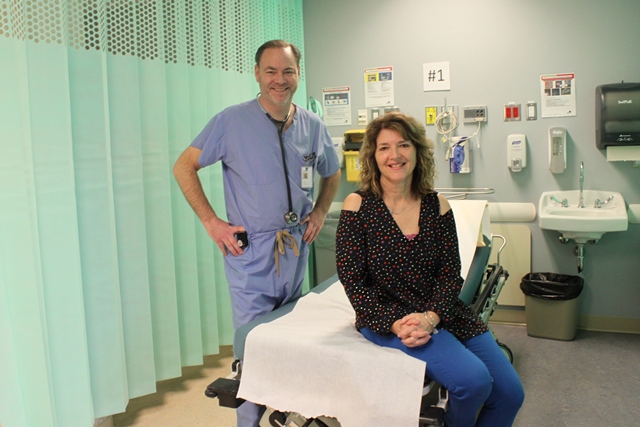By Anne Kelly
Within an hour after having a cancerous lobe of her lung removed, Michele Way was walking around the recovery room at St. Mary’s General Hospital in Kitchener. She went home the next day and within a couple of weeks was walking 70 minutes a day.
The 56-year-old Waterloo woman credits her quick recovery with an innovative model being used for minimally invasive lung cancer surgery at St. Mary’s. Called Enhanced Recovery After Surgery (ERAS), it changes how patients prepare for surgery, how they are supported in hospital and at home, and how pain and fluids are managed during surgery.
“I have no doubt I was 100 per cent better recovering at home,” says Michele, a non-smoker. “St. Mary’s provided the tools and resources I needed to work for my own wellness.”
Dr. Paul Chiasson, a thoracic surgeon at St. Mary’s says the ERAS approach for lung cancer surgery “requires a paradigm shift in attitude for patients and staff. Patients feel empowered to help themselves get better. There is a marked reduction in post-operative complications and hospital stays are shorter, saving health care dollars. Patient satisfaction is greatly improved with a quicker return to home and work,” he says.
Some centres in Canada are using components of ERAS with lung cancer patients, adds Matthew Dubuc, a Nurse Practitioner and Registered Nurse First Assistant at St. Mary’s. “To our knowledge we are the only centre in Canada to fully implement ERAS for video assisted lung cancer surgery,” he says,
ERAS patients must comply with a pre-surgery regimen of exercise, healthy eating, pain medication and smoking cessation. During surgery, local anesthetic nerve blocks are used rather than an epidural, allowing patients to be mobile and comfortable soon after surgery. They are given fewer narcotics, resulting in less post-operative drowsiness, nausea and dizziness. Fewer intravenous fluids reduce the chance of post-surgery injury to the lungs.
Within an hour after surgery, patients are fed and walking with a family member who continues to walk with them every hour until bedtime. Those who have a small wedge of their lung removed are discharged the same day, versus two-to-three days. Patients having a lobe of lung removed go home the next day, versus four-to-five days.
St. Mary’s is a Level One Centre for Thoracic Surgery, completing a minimum of 120 lung cancer surgeries per year. It implemented the ERAS model in August of 2016 after visiting a Virginia hospital which was using it for lung cancer patients.
The model relies on another St. Mary’s innovation, the Integrated Comprehensive Care Program (ICC), to provide a home visit from a nurse prior to surgery who ensures patients have done the required preparations. ICC arranges an in-home nursing visit a day after discharge (and again if necessary). ICC care coordinators are available by phone 24/7 to answer questions for up to 60 days after surgery.
Clinical Nurse Educator Christa Saunders says the support and encouragement patients receive prior to their surgery helps motivate them. “These patients are determined by the time they arrive for surgery that they are not going to spend several days in hospital,” she says.
Patients visit their surgeons for follow-up one month later. “Their recovery is accelerated remarkably,” says Dr. Chiasson. “After two weeks, they are generally at a level we would have previously seen at four or five weeks post-operatively.”
He says St. Mary’s is now considering how the ERAS model could be used with other types of surgery. “I think it is the way of the future.”
Anne Kelly is Manager of Communications at St. Mary’s General Hospital in Kitchener.


